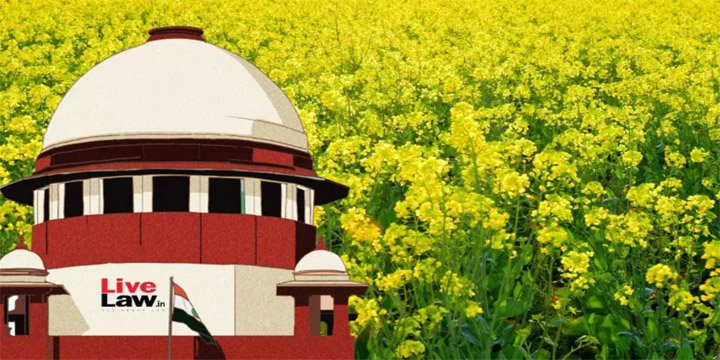SC ON GM MUSTARD
A two-judge Bench of the Supreme Court on Tuesday (July 23) delivered a split verdict on whether to allow the “environmental release” of Genetically Modified (GM) mustard.
WHAT IS ENVIRONMENTAL RELEASE?
It is a method of assessing the impact of GM crops on the environment. These impacts can
be positive (can reduce the need for herbicide & pesticide) as well as negative (can be
invasive to the native species)
THE CASE
Justices B V Nagarathna and Sanjay Karol disagreed on whether the approval given by the Genetic Engineering Appraisal Committee (GEAC) — the body that is responsible for approving proposals relating to genetically engineered organisms — to proceed with field trials following the environmental release was done properly.
This was the GEAC’s second major push to introduce GM mustard as the first GM crop that is meant for human consumption.
Bacillus thuringiensis cotton (or Bt cotton) is the only GM crop that has been approved for cultivation in India so far.
WHAT HAPPENS NOW?
When a split decision is delivered, the case is referred to the Chief Justice of India for placing before a larger Bench. However, both judges directed the Union of India “to evolve a National Policy with regard to GM crops”, and to consult experts, farmer representatives, and state governments during the process.
THE STORY OF GM MUSTARD
- On September 15, 2015, the Centre for Genetic Manipulation of Crop Plants (CGMCP) at the Delhi University sought the GEAC’s approval for the environmental release of a genetically engineered hybrid mustard called DMH-11 (commonly known as GM mustard).
- Along with the proposal, the CGMCP submitted a biosafety dossier, and the GEAC created a sub-committee to examine its contents. Following some revisions, the sub-committee considered the dossier and submitted its report. In September 2016, the report was published and comments were invited.
- On May 11, 2017, the GEAC recommended the environmental release of GM mustard. If approved, this would allow field tests to be conducted to examine the effects of cultivating the crop.
- However, after receiving several representations, the Ministry of Environment sent the proposal back to the GEAC for re-examination in March 2018.
- The GEAC then directed the CGMCP to examine the effect of GM mustard on honey bees and soil microbial diversity. But these tests were deferred through 2020-21.
- In May 2022, gene scientist Prof Deepak Pental on behalf of the CGMCP wrote to the Minister for Environment urging him to accept the recommendation for the environmental release of GM mustard.
- The GEAC sought comments from various government departments, which recommended releasing GM mustard.
- The proposal was submitted on October 18, 2022. It was accepted by the Centre on October 25, and recommendations and conditions regarding the field tests were sent to Prof Pental.
THE ROADBLOCK
Environmentalist Aruna Rodrigues and the research and advocacy organisation Gene Campaign challenged the decision to approve the environmental release of GM mustard before the Supreme Court.
THE SC ON THE CASE:
In their split decision, the judges disagreed on two key aspects:
- Whether the GEAC’s decision-making process was legal and,
- Whether it violated the “precautionary principle” for scientific innovations.
- The precautionary principle, a standard test in environmental litigation, is recognised as a facet of the right to a clean environment, a subset of Article 21 (fundamental right to life).
ADVANTAGES OF GM CROPS
- Increase productivity and prevent crop loss: GM crops are resistance to insect damage, tolerant to herbicides, resistance to plant viruses which help farmers prevent crop loss and increases the crop productivity.
- Food security: With increase in population demand of food also increasing, to address this GM crops help foods to become more accessible and affordable for consumers.
- Enhanced nutritional quality: Many varieties of GM food crops have been developed, to enhance nutritional quality. Eg. Golden rice is a transgenic variety in rice, which is rich in vitamin A.
- Maintain soil fertility: GM crops have increased efficiency of mineral usage that reduces excess use of fertilizers and prevents loss of fertility of soil.
CHALLENGES WITH GM CROPS
- Bio-safety of human and animal health: Risk of toxicity, due to the nature of the product or the changes in the metabolism and the composition of the organisms resulting from gene transfer.
- Environmental concerns: Since a GMO is artificially created, its breeding with the other crops in the natural ecosystem can result in genetic contamination.GM technology could also allow the transfer of genes from one crop to another, creating super weeds which might be immune to common control methods.
- Economic concerns: Yields of GM crops have turned out to be false. For example, in India, with its Bt cotton experience, cotton yield has stagnated around 460 kgs per hectare in the recent past, despite most cotton being GM.
- Ecological concerns: GM crops could lead to erosion of biodiversity and pollute gene pools of endangered plant species.
WAY FORWARD:
- Awareness and information: Public awareness with reliable evidence-based information on GM crops such as keeping biosafety data out of the public domain needs to be increased to take informed decisions.
- Government roadmap: The government should come up with a fresh road map for ensuring food security without jeopardising the biodiversity and compromising with the safety of human health.
- Capacity building: There is need of capacity building in GM research agenda and development with science based consistent regulatory policy.
- Robust clinical trials: Clinical trials of GM crops need to be contingent on robust demonstration of safety and efficacy.
Note: Connect with Vajirao & Reddy Institute to keep yourself updated with latest UPSC Current Affairs in English.
Note: We upload Current Affairs Except Sunday.


